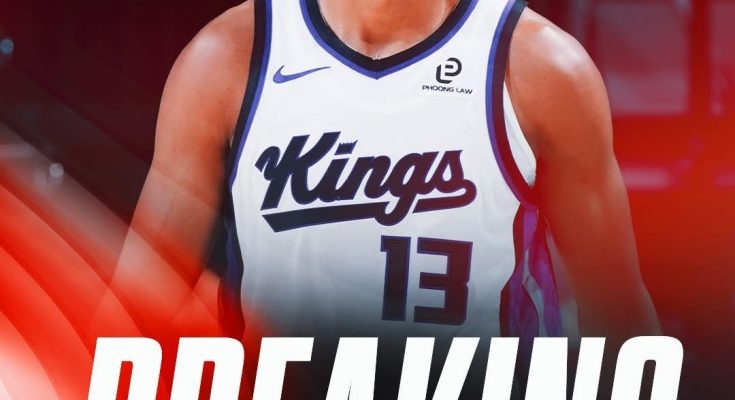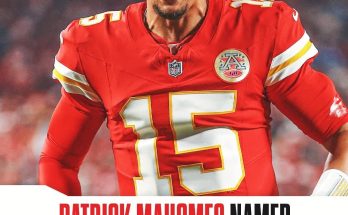When the news broke that Keegan Murray had agreed to a five‑year, $140 million rookie contract extension with the Sacramento Kings, it immediately sent ripples across the NBA world. According to ESPN’s Shams Charania, the deal locks Murray in through the 2030–31 season, giving the Kings control over one of their young foundational pieces well into the next decade
At first glance, this is a major vote of confidence. The Kings are signaling that they see Murray not just as a rotation player, but as a core building block. This kind of commitment — before he even reaches unrestricted free agency — shows they believe in his long-term upside. But buried in that optimism are all the caveats and risks that come with locking in a young player before he’s fully proven.
To understand why the Kings might have made this move, it helps to look at Murray’s trajectory so far. Drafted 4th overall in 2022, he showed from the start that he had a two‑way game that could develop into something special. In his rookie year, he stepped right into a starting role, contributed at both ends, and helped snap Sacramento’s long playoff drought. (SI) Over his first three seasons, he’s been durable, appearing in 233 of a possible 246 games, with the offense and defense around him often relying on his consistencyLast season he averaged 12.4 points and put up a career high in rebounds (6.7 per game) while logging 34.3 minutes a night. (ESPN.com) His shooting has had ups and downs — he shot 44.4 % overall and 34.3 % from three on 5.9 attempts per game last year. (NBA) Defensively, he’s earned respect for guarding high-end wings, being Sacramento’s primary perimeter defender, and consistently being among those assigned to defend All‑Star level opponents. (ESPN.com) He is also one of the few players in the league to accumulate, over this early stretch, at least 500 made threes, 150 blocks, and 150 steals.
So the foundation is there. The Kings see in Murray someone who can contribute on both ends, someone who has already shown durability, and someone who still has room to grow. If he hits more consistency in his shotmaking, becomes a more commanding force on offense, and continues to guard at a high level, then this extension could look like a tremendous bargain.
But there are risks. For one, future performance is never guaranteed. By giving him five years, Sacramento is betting on sustained or improved production, especially in areas like shotmaking, offensive creation, and finishing at the rim. There’s also the injury risk. Murray is currently recovering from surgery after tearing the ulnar collateral ligament (UCL) in his left thumb, an injury he sustained in preseason play. (ESPN.com) The expected recovery time is 4‑6 weeks, though medical experts note it may take longer before he’s truly 100 % and can play without protection. (basketballinsiders.org) That means he will miss at least the early stretch of the 2025‑26 season, robbing the Kings of one of their more important pieces out of the gate. (ESPN.com)
Another challenge is that Murray’s offensive numbers have dipped a bit from his sophomore season (when he averaged ~15.2 ppg) to last season’s 12.4. (FOX Sports) That suggests either a shift in role, less usage, or maybe adjusting to more defensive assignments or roster changes. Locking in a large contract now means Sacramento is taking on that performance risk. If Murray stagnates or regresses, the contract could become a burden. In the world of NBA contracts, long deals for wing players who don’t consistently space, shoot, or create can turn into albatrosses.
From the Kings’ perspective, there’s also the question of roster flexibility. Committing $140 million over five years to Murray means less wiggle room for other extensions, free agent signings, or trading flexibility in the future. That said, securing a young, ascending piece might be worth the cost if it helps the team stay competitive and gives them a stable foundation around which to build.
One more dimension: the extension comes just as Sacramento also agreed to terms with veteran Russell Westbrook on a one‑year deal (reportedly $3.6 million). (FOX Sports) That suggests the Kings are trying to mix youthful upside with veteran presence — perhaps to guide the young core, help with leadership, or fill short‑term gaps while Murray recovers. But that kind of veteran addition can also complicate rotations, roles, and developmental pathways for younger players.
Looking broader, this extension will have ripple effects beyond Sacramento. For players in Murray’s draft class or those in similar “young wing” positions, this deal might serve as a benchmark. It tells the market that teams are willing to ante up for promising two‑way wings, even if their counting stats aren’t yet elite. For comparisons: Shaedon Sharpe (drafted three picks after Murray) might now look to use this contract as a reference point. (Blazer’s Edge) If Sharpe maintains his scoring upside, that Murray’s deal becomes a yardstick for where he should land. Within Sacramento, this extension also sends a signal to other young players in the system: Murray is the kind of player the franchise wants to retain long-term.
It’s worth imagining scenarios. If Murray improves — his shot stabilizes, he becomes more assertive offensively, his defense remains elite — this extension might look like a steal. He could become a 20+ point scorer, stretch the floor, cover multiple positions, give the Kings star-level production on the wing, and maybe even emerge as an All-Star candidate. The value of locking that in before the price doubles or triples is high. On the flip side, if his shot remains erratic or his offensive impact never scales, or if injuries intervene, the burden of the contract could hamper Sacramento’s flexibility and force them to bail or trade him under less favorable terms.
For Murray himself, this contract gives security. It means he doesn’t have to stress over proving himself every single night in the short term. He’ll have time to develop, recover, adjust, and grow without the pressure of next-season contract uncertainty. It also gives him bargaining power — he’s locked in, but if he overperforms, he could be in position for another big payday or leverage in trade talks. Yet it also puts a target on his back — expectations will rise. Fans, media, and the front office will expect growth, improvement, and consistency. A downturn or a quiet season will attract scrutiny.
For the Kings, this signals that they’re trying to lean into youth, continuity, and internal development, rather than chasing big name free agents or swinging for splashy but uncertain bets. It tells the league: we believe in what we’re building, and we’re going to back it financially. If the supporting pieces around Murray work out — complementary shooters, interior defense, smart coaching — then this extension could become a linchpin of a sustained competitive core.
One challenge in all of this: the timing. Giving this extension now, while Murray is injured, introduces more risk. They are committing resources while his health is not yet assured. Also, in the early season without him, the Kings may struggle in rotations or chemistry. How they manage his return, integrate him back into the system, and balance minutes will be crucial. Moreover, the contract may reduce flexibility for future trades or signings, especially if the salary cap doesn’t rise as fast as anticipated or if other players demand big deals.
Still, there’s optimism. Murray is not just another lottery pick — he’s shown grit, consistency, defensive chops, and flashes of offensive promise. The Kings love to believe in players who improve steadily. If Murray can become a consistent 17–20 point contributor, stretch the floor, create his own shot more effectively, and stay healthy, this will be one of the smarter early extensions in recent years.
At 25 years old, entering his fourth season, Murray is now firmly in his prime development years. This extension spans ages when many wings blossom. The curve is ahead of him. If Sacramento can surround him with talent, coaching, and structure, they may get tremendous upside. But in the pressure cooker of NBA expectations, he’ll have to deliver.
In the end, this deal is a calculated bet by the Kings. They’re betting on Murray’s promise, development, and two‑way potential more than on established star attraction. It’s a bet on trajectory rather than status. For Murray, it’s security and expectation bundled into one package. For fans and observers, it’s a commitment — the Kings are saying: this is our guy, and we’re going to build around him.
Whether in five years this will be praised as a visionary move or questioned as a miscalculation hinges on how Murray’s next seasons unfold. If he becomes the kind of player who carries a team, this contract will look like genius. If he plateaus or can’t make the leap, it might haunt Sacramento. But that’s the nature of NBA extensions — no outcome is guaranteed, but the potential upside is enticing.


